

Hypomyces lactifluorum, the lobster mushroom, Tom Volk's Fungus of the Month for August 2001. This month's fungus is Hypomyces lactifluorum, the lobster mushroom For the rest of my pages on fungi, please click This month's fungus is Hypomyces lactifluorum, the lobster mushroom.
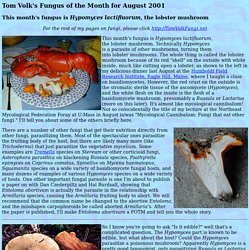
Technically Hypomyces is a parasite of other mushrooms, turning them into lobster mushrooms. The whole thing is called the lobster mushroom because of its red "shell" on the outside with white inside, much like cutting open a lobster, as shown to the left in my delicious dinner last August at the Humboldt Field Research Institute, Eagle Hill, Maine, where I taught a class on basidiomycetes. However, the red crust on the outside is the stromatic sterile tissue of the ascomycete (Hypomyces), and the white flesh on the inside is the flesh of a basidiomycete mushroom, presumably a Russula or Lactarius (more on this later).
There are a number of other fungi that get their nutrition directly from other fungi, parasitizing them. Cultivating Lobster Mushrooms? - Gourmet and Medicinal Mushrooms. Is this possible?
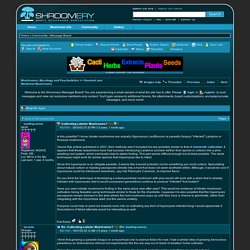
I know lobster mushrooms are actually Hypomyces Lactifluorum (a parasitic fungus) "infected" Lactarius or Russula mushrooms. I found this article published in 2001; their methods aren't included but are probably similar to that of chantrelle cultivation. It appears that these researchers have had success introducing Lactarius (unclear wether from spores or culture) into a pine seedling root system, which eventually lead to stable fruiting.
This part seems difficult enough but at least possible. The same techniques might work for similar species that Hypomyces like to infect. HOW TO: Grow your own mushrooms from recycled cardboard and coffee grounds. Book lovers and coffee drinkers no doubt have an excess of cardboard and coffee grounds on their hands.
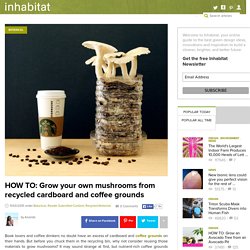
But before you chuck them in the recycling bin, why not consider reusing those materials to grow mushrooms? It may sound strange at first, but nutrient-rich coffee grounds and corrugated cardboard are a match made in mushroom heaven. All you’ll need is a plastic container cleaned with rubbing alcohol and perforated with four to six quarter-inch holes; corrugated cardboard that’s been soaked in water for at least one to two days; quality mushroom spawn that can be found online; and spent coffee grounds, ideally from the day-of. Starting with the cardboard, layer the materials in the container like you would lasagna and cover each sprinkle of spawn with coffee grounds. Then, watch the magic happen! + A Piece of Rainbow The article above was submitted to us by an Inhabitat reader. A Helmet Made of Mushroom Fiber? Whoever said internships had to be boring?
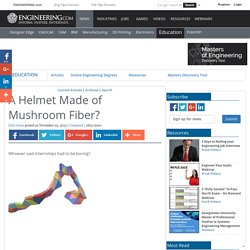
This simulation shows how the geodesic structure would unfold into an easily stashed strip. (Image courtesy of Autodesk.) Six students, chosen to participate in Autodesk’s Applied Innovation Internship, spent their summers at Autodesk’s Pier 9 facility. Their mission? To create an original design and push the limits of Autodesk’s CAD/CAE/CAM platform Fusion 360. Radical Mycology book to be released February 2nd. After two years in the making, the book Radical Mycology is set to release February 2nd, 2016!
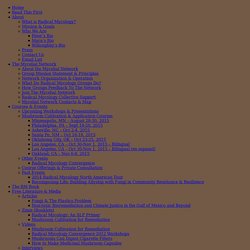
Stay tuned for more info on how to order the book. Pages: 600 pages Book Art: Black and white illustrations and photographs throughout, color plate center section Size: 8 x 10 inch Pub. Fungi are found throughout the world, often playing critical roles at the center of all ecological webs. In 2006 Peter McCoy founded Radical Mycology, a grassroots organization dedicated to increasing awareness of the many ways to work with fungi for personal, societal, and ecological health. Plastic-Eating Mushroom Discovered in the Amazon Rainforest — A Solution for Our Trash Saturated World?
By Carolanne Wright Contributing Writer for Wake Up World In a world addicted to plastic, it’s hard to imagine life without it.
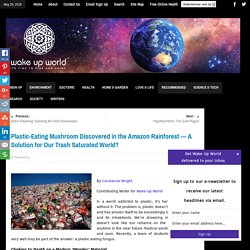
The problem is, plastic doesn’t breakdown safely and has proven itself to be exceedingly toxic for the planet and its inhabitants. Matsutake culture medium for clay seed pellets - Masanobu Fukuoka. The Amazon Mycorenewal Project. How to Harvest Microbes from the Land to Build Your Soil- Know Your Soil! Better Batteries Through Mushroom Technology. Mushrooms never cease to amaze.
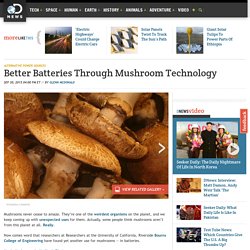
They’re one of the weirdest organisms on the planet, and we keep coming up with unexpected uses for them. Actually, some people think mushrooms aren’t from this planet at all. Really. Now comes word that researchers at Researchers at the University of California, Riverside Bourns College of Engineering have found yet another use for mushrooms — in batteries. Mushroom Building Bricks That Are Stronger than Concrete. Mycologist Philip Ross is seriously into mushrooms, but not as a food -- instead, he uses fungi as a building material.
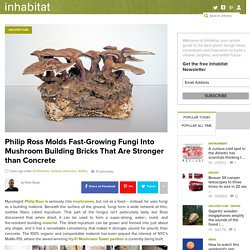
Beneath the surface of the ground, fungi form a wide network of thin, rootlike fibers called mycelium. That part of the fungus isn't particularly tasty, but Ross discovered that when dried, it can be used to form a super-strong, water-, mold- and fire-resistant building material. Field And Forest Products, Inc. The Trouble With Tailings: Toxic Waste ‘Time Bombs’ Loom Large Over Alaska’s Salmon Rivers. There are a few unarguable truths about mine tailings, the pulverized rock, water and sludge left over from mineral extraction — mining is a messy business, the leftovers have to be dealt with forever and it’s impossible to guarantee against another tailings dam failure such as the Mount Polley catastrophe.

In B.C., there are 98 tailings storage facilities at 60 metal and coal mines, of which 31 are operating or under construction and the remaining 67 are at mines that are either permanently or temporarily closed That means communities throughout B.C. and Alaska are looking nervously at nearby tailings ponds, which sometimes more closely resemble lakes, stretching over several square kilometres, with the toxic waste held back by earth and rock-filled dams. The water is usually recycled through the plant when the mine is operating, but, after the mine closes, water, toxins and finely ground rock must continue to be contained or treated. Agarikon & Shaman Grave Guardians — Fungi.net. If you find Agarikon, please do not pick it !

We need to protect the natural genome. Our studies show that Agarikon's mycelium contains active components, and that Agarikon fruitbody is an astringent, and indeed in high doses may be deleterious or even toxic. We do not yet fully understand the biochemical transformation from the brown to the white form. I found the white form featured here laying dead on the ground on my property. The other was given to me by people motivated to save this strain as the old growth forest habitats are threatened. Stamets, how mushrooms can save bees. Honeybee populations have been plummeting for nearly a decade throughout the United States. Now, two scientists in Washington state are teaming up to help the pollinator, and they’re investigating an unconventional source for their remedy: the mushroom.
Eric Olson clutches the lid on top of his wooden beehive. He slowly lifts it up and peeks inside at thousands of stinging insects. Olson has been a beekeeper in eastern Washington for half his life. The Mushroom Feast: A Celebration Of All Edible Fungi With Over 250 Receipes by Jane Grigson. MushroomCultivationGuide. Cultivating Edible Mushrooms with Dave Wichland. Reclaiming Broken Places: Introduction to Civic Ecology. Mycofiltration Enters the Commons. A line of mycelium-and-substrate-filled bags in Mason County, Washington. Fungi Perfecti founder and director of research, Dr. Paul Stamets, announced today the release of mycofiltration and mycorestoration as public domain terms and technologies. The move formalizes a long-standing company policy of “teaching the teachers” the art and developing science of mycofiltration through annual seminars, workshops, and lectures.
Stamets made the move to fully disclose mycofiltration as public domain to clear up any remaining doubt about the intellectual property status of the technology. The technology, known as “mycofiltration” refers to the intentional and judicious use of cultivated networks of fungal mycelium to facilitate water quality improvements in engineered ecosystems. Shroom: Mind-bendingly Good Recipes for Cultivated and Wild Mushrooms by Becky Selengut. Start by marking “Shroom: Mind-bendingly Good Recipes for Cultivated and Wild Mushrooms” as Want to Read: Enlarge cover Error rating book. Refresh and try again. Radical Mycology on Vimeo. Spawning Mycelial Networks: The 2014 Radical Mycology North American Tour. All photographs by Peter McCoy, unless noted In August of 2014, members of the Radical Mycology Collective set out on a 3-month tour across North America to share their mycological knowledge with a over 40 different volunteer groups, non-profits, activist spaces, food justice centers, art collectives, and mycological societies.
As self-educated mycologists, the tour members knew that mycology has historically been a study of the few and difficult to access for most people, despite the incredible insights and global resilience that comes from working with fungi. Radical Mushrooms: Taking DIY fungi cultivation global. Radical Mycology: Training a Mushroom to Remediate Cigarette Filters. The Plan to Mop Up the World's Largest Oil Spill With Fungus. Improving Soil Fertility With Fungi.
Making a more fungal compost has been an aim of mine for some time. Mushrooms, Peyote and Ayahuasca: Sacraments from Nature, Panel Discussion at Bioneers 2014 — Fungi.net. Following the Mycelial Path to Discovery and Saving the World. By Carolyn Shea Paul Stamets ’79 turned his teenage curiosity about mushrooms into a singular path that not only led him to become a leading mycologist, entrepreneur, and author, but also put him on a trailblazing journey of discovery. Stamets has been a devoted acolyte, emissary, and evangelist of the fungi for more than four decades. Campaign.r20.constantcontact. 2014 Radical Mycology Convergence Reportback. 2014 Radical Mycology Convergence Reportback. Paul Stamets. Paul Stamets has been a dedicated mycologist for over thirty years. Is This Fungus the Future of Farming? Mycorrhizal fungi growing on a petri dish in Alia Rodriguez's lab Cynthia Graber This article was originally published on Gastropod. Unless you've been living under a rock for the past couple of years, you've probably heard about the human microbiome.
Groworganic mushroom kits and videos. Mycomedicinals: An Informational Booklet on Medicinal Mushrooms by Paul Stamets. 2014 Morel Sightings Map. Mushroom Observer: Activity Log. MushroomExpert.Com. The Hoosier Mushroom Society - Indiana Mushrooms. North American Mycological Association. Shroomery - Magic Mushrooms (Shrooms) Demystified. Mycotopia. The Mushroom Farm - Gourmet Mushrooms, Cultivation, and Hunting Supplies. Magnificent Mushrooms. Organic Mushroom Farming and Mycoremediation: Simple to Advanced and Experimental Techniques for Indoor and Outdoor Cultivation by Tradd Cotter. Mycorrhizal Fungi: The Amazing Underground Secret to a Better Garden. Throughout history, people’s explanations of life involved all kinds of wonderful stories and complex philosophies. Earth Repair: A Grassroots Guide to Healing Toxic and Damaged Landscapes by Leila Darwish. Mushroom Cultivation for Remediation.
DIY: How to Find, Forage and Cook Your Own Wild Chanterelle Mushrooms. Using Fungi to Remediate Radiation at Fukushima. 5 Easy Ways to Preserve Mushrooms. Video: Why Waste Coffee Grounds When Delicious Mushroooms Love to Grow on Them? Homepage - GroCycle. Radical Mycology with Peter McCoy (PVP080) The Mushroom Forager – ForageCast: Fall Feast. Make a Living from Growing Mushrooms. The Complete Guide to Cultivating Mushrooms by Stephen Russell. Mushrooms for the Million - Growing, Cultivating & Harvesting Mushrooms by John Wright. Mushroom Wisdom: Cultivating Spiritual Consciousness by Martin W. Ball. The Cultivation of Mushrooms by W. F. Bewley. Mushrooms: Cultivation, Nutritional Value, Medicinal Effect and Environmental Impact by Shu-Ting Chang. The Complete Mushroom Book: Savory Recipes for Wild and Cultivated Varieties by Antonio Carluccio. Eagle Bluff Environmental Learning Center. Using plants to clean contaminated soil. Mycorrhizal Fungi: The Amazing Underground Secret to a Better Garden.
Shiitake Mushroom Logs, Grow Your Own Shiitake Mushrooms - New. Mushroom Kits you grow at home by Mushroom Adventures. Mushroom-growing Supplies Field & Forest, Proud to be part of this rotting world! Gmushrooms Gourmet Mushrooms Lions Mane growing lits and log plugs. Lion's Mane Mushroom Log Kit. Organic Mushroom Growing Kits, Lions Mane Reishi, Mitake, Morel, oyster. Gardening Gifts - Lion's Mane Mushroom Kit Organic. Organic Mushroom Growing Kits.
Mycorestoration for Balanced and Thriving Ecosystems - Earth Action Mentor. Grow Gourmet Mushrooms on a Small Farm. Organic Mushroom Farming and Mycoremediation by Tradd Cotter. Kill the Land, Kill the People: There Are 532 Superfund Sites in Indian Country! U.S. EPA to begin soil cleanup at homes, roads near Sulphur Bank Mercury Mine Superfund Site. Mycoremediation (Bioremediation with Fungi) – Growing Mushrooms to Clean the Earth. A mini-review. Mycorestoration for Balanced and Thriving Ecosystems - Earth Action Mentor. Mycelium Running: How Mushrooms Can Help Save the World by Paul Stamets. Amateurmycology.com. How to Grow Gourmet, Medicinal and Edible Mushrooms with mushroom Grow Buddy by Sandra Anderson. Growing Gourmet and Medicinal Mushrooms by Paul Stamets. Portland's E. Coli Scare: How Mushrooms Could Have Helped Prevent It by James Trimarco. Mighty Mycorrhiza. Free Catalog. Mushrooms Used for Bioremediation to Clean Pesticides From Oregon Waterways.
Mycoremediation. Mycoremediation. Seminars.